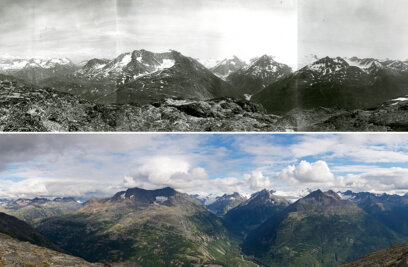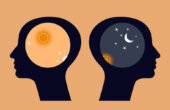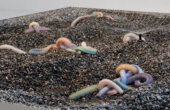A Crisis of Vision: Can Art Shake Humanity From Its Global Stupor?
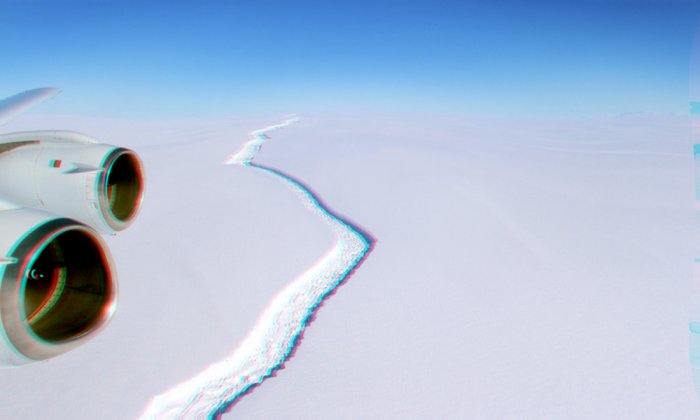
One of the most frequent clichés animating calls to action is: If not now, when? When is an interesting word. It doesn’t always demand, or even imagine, a future, and it may very well point to the past. Either way, however, when is always firmly rooted in the present — from this point in time, when did or will we leave? When did or will you do something? When did or will I finally understand?
Perhaps no aspect of contemporary visual culture is more concerned with when and its relation to the now than images devoted to the diverse ways humanity locates itself and its place, and cares for or devours the resources of earth and space. It is a visual culture of urgency, dread, hope, and regret, because it has come to focus so intently on the visual record of global warming and climate change and grappling with the potential devastations of the future.
“When?” carries a tinge of the existential — for every person, at some point — but the visual cultures of climate crisis address the question collectively to humanity, looking not to mere death but to extinction.
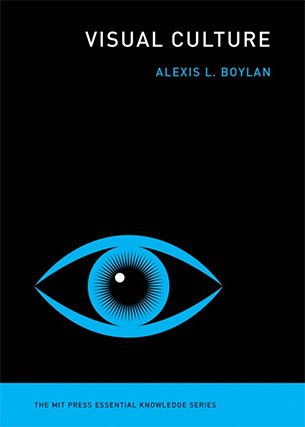
In the novelist Amitav Ghosh’s 2016 book “The Great Derangement,” he seeks to address why artists, such as himself, can’t seem to get their heads and imaginations around the growing climate crisis. He is unrelenting in his assessment that this is not merely some unfortunate omission, but potentially the very heart of the reason for the global human community’s feeble attempts to change habits and actions, or to address the growing evidence that we are destroying our planet. Ghosh sees a great deal of blame to be shared all around, but argues ultimately that “when future generations look back upon the Great Derangement they will certainly blame the leaders and politicians of the time for their failure to address the climate crisis. But they may well hold artists and writers to be equally culpable — for the imagining of possibilities is not, after all, the job of politicians and bureaucrats.”
It is literally a crisis of vision. Ghosh demands that we consider how visual culture has failed to show us the problem and the stakes, how it has failed to make us see. He points to the terrible consequences: Because we don’t see the emergency, we fail to address it. To think on this in another way, what might be shown, and how would that make the world see? Clearly, the tragic animated scene of a sad-eyed polar bear unable to climb up onto a shrinking ice float from former Vice-President Al Gore’s documentary “An Inconvenient Truth” didn’t do the job. The answer to “When?” clearly isn’t 2006.
It is important here to clarify the “we” and “us” in the story of climate change. Often in dialogues about the environment there is a tendency to obscure culpability or disperse blame within general narratives of possibility and progress: “We all got in this mess, how are we going to fix it?” On the other hand, there are clearly identifiable segments of the global population who will bear an outsized burden from the violent consequences of climate change — who already are. To combine those who have disproportionately profited and those who have and will disproportionately suffer as if they share blame or costs performs another cruel and unjust erasure. Industrial nations, corporate capitalism, and the elite and middle classes in Europe and the United States bear the majority of the responsibility, and have also crafted the rhetorical, political, and economic paradigms that justify emerging economies and new world powers in exacerbating these problems. It is the world’s poor and formerly colonized of the Global South who suffer first and most, again.
“When?” carries a tinge of the existential, but the visual cultures of climate crisis address the question collectively to humanity, looking not to mere death but to extinction.
This brings “us” to another bit of controversy “we” need to confront: When, exactly, are we? Some have come to think of this period — this when — as the Anthropocene. First posited by geologists, the term names a new epoch in the earth’s geologic time during which the impact of humans is so significant as to be the dominant factor shaping and changing every ecosystem, the land, the sea, the planet’s atmosphere; no aspect of life on Earth remains untouched by human actions. This time is different, necessitating, some argue, the designation of a new epoch. Almost as controversial as the suggestion of a new epoch is the identification of when it could be said to have started. Suggestions range from the spread of human agriculture (about 8,000 years ago) to the steam engine (1712) and the first nuclear detonation (1945).
Proponents of the Anthropocene designation have met with significant backlash. Much of it revolves around the charge of anthropocentrism or human arrogance in some form. Many have convincingly argued that the term works to naturalize human superiority and privilege human behaviors, or that it does not address the epic imbalance among humans in terms of responsibility for the changes. Thus, whereas scholars like Dipesh Chakrabarty find the Anthropocene to be a politically and ideologically useful term, others such as Gayatri Spivak and Bruno Latour have made convincing and urgent use of the term “planetary” instead to focus on the need to rethink and recreate (rather than simply rename) senses of time, place, and relationships among and within species and environments.
Acts of seeing and not seeing, erasure, and imagination are at the very heart of climate change narratives, as is that inevitable question, “When?” Ghosh’s accusation is also a call to action. When will humanity be motivated by what we see or are shown? The visual culture theorist Nicholas Mirzoeff argues that “the first step is to recognize how deeply embedded in our very sensorium and modern ways of seeing the Anthropocene-aesthetic-capitalist complex of modern visuality has become.”
The visual realm has, in fact, been an incredibly, even devastatingly effective tool for shaping people’s understandings of the environment, their pleasures in it, and their threats and obligations to it. Anyone here scared to go in the water because of sharks? Got a visual on that? What we know of the natural world is bound up, for better or worse, with visual culture.
In order to consider carefully our inherited stories about the earth and the things that live on it, the scholar Donna Haraway argues that we must “stay with the trouble.” This means resisting the compulsion to look away, but also inhabiting trouble, being in it, making it, and healing it now, in the present, not when. Haraway calls us to “stir up potent response(s) to devastating events, as well as to settle troubled waters and rebuild quiet places.” This is a tall order, and as we have seen in previous chapters, a lot of images stand in the way. Yet a productive visual culture, one that inspires action, attention, and being in the now, Ghosh begs us to understand, is also possible and imperative. As always, visual culture is both problem and solution to figuring out when.
If not now . . .
Visually speaking, the picture doesn’t really look like much. Mostly white ice and snow, with a gentle ombré on the horizon line that moves the color from white to a rich sky blue. The zigzag rupture does not look that ominous on its face. It could be the track of some motorized vehicle, some crooked path from one place to the next. You could even be forgiven for imagining it was made by a dog sled. In the left corner of the frame hangs a plane’s wing and engines, anchoring the viewer firmly inside the plane, looking out a window.
Scholar Alex Bush describes this image differently: “I found myself unable to bear witness to the rupture in Larsen-C” as it is “too horrifying to contemplate.” It is “seeing the death of the entire earth, and all its inhabitants, in advance.” The key to Bush’s distress is the mention of “Larsen-C,” which designates an ice shelf in the Antarctic. These shelves have been monitored by scientists with increasing anxiety, as global warming has already caused several of them to break apart, suggesting a start to the fundamental reshaping of the planet.
While Larsen C had already lost several parts, in 2016 a far more significant rift was identified, first in satellite imagery, then, when weather permitted, by direct visual confirmation. This photograph is evidence of that confirmation. The line is definitely not tracks in the snow; it might be the beginning of the end of humanity and most other life on earth. For Bush, this photo is the end of the world as we know it — a mass death foretold, a horror show. It is a photograph that cannot be looked at because it is a picture of when, and the deadline has passed.
Film studies scholar E. Ann Kaplan might wonder whether what Bush is speaking of here is “Pretraumatic Stress Syndrome” (PreTSS), wherein trauma is suffered in advance of a climate apocalypse. Film viewers and fiction fans see climate annihilation coming and they are already damaged by it. Kaplan suggests this condition is a major preoccupation in contemporary literary and film output. Readers and filmgoers are being fed repeated images of climate disasters and their dystopian outcomes. Besides science’s “real” images, there is no end to made-up ones that can play out all our worst nightmares.
This is exactly the opposite of what Ghosh says we need. This is the kind of art, the kind of imagination that pulls us back into ourselves, not outward to collective action, and certainly not to when. As scholar Rob Nixon asks, “How can we convert into image and narrative the disasters that are slow moving and long in the making, disasters that are anonymous and that star nobody?”
As scholar Rob Nixon asks, “How can we convert into image and narrative the disasters that are slow moving and long in the making, disasters that are anonymous and that star nobody?”
So we return to Larsen C, and to documentary film, satellite imagery, illustration, charts, memes, computer simulations, endless visuals created by human and nonhuman alike. The fact is, there is already a robust visual culture of ways to see the evidence of what is happening to the planet. Graphics and countless charts and clusters arrange and rearrange data and beg for eyes and action. Much time, attention, and talent are invested in creating the right collage of imagery that will shake humanity from its global stupor and incite action.
Yet, as Bush’s response to the ruptured Antarctic ice shelf image suggests, images can backfire, making things appear too desperate, too sad, too hopeless (recall Al Gore’s polar bears). We look away instead of confronting our when. The documentary and factual might falter, but other makers have imagined ways to resee the world and its environments. Contemporary artist Valerie Hegarty looks back to august Western landscape history to grab the viewer’s attention and emotion in order to generate new sight and new action. As Hegarty writes to me an email, describing her work “Warped Landscape”:
[It] is a ceramic work that continues my interest with appropriating iconic images from American History and altering them in ways that critique their content. I painted the landscape with underglaze as a loose and diminutive copy of Albert Bierstadt’s Among the Sierras from 1868 — the original a heroically scaled sweeping view of pristine and abundant western woodlands. Part fact and part fiction, it was these idealized landscapes — also devoid of Indigenous peoples — that helped strengthen the idea of manifest destiny, that America was the “Promised Land” encouraging European settlers to push westward. The crumpling of the work refers to the gesture of the artist that has made a failed image. The rendering of the image and crumpling in ceramic concretizes the failure of the American myth to reflect the brutal reality of the violence wrought in the name of expansionism and industrialization, including the decimation of indigenous peoples and the destruction of the landscape itself.
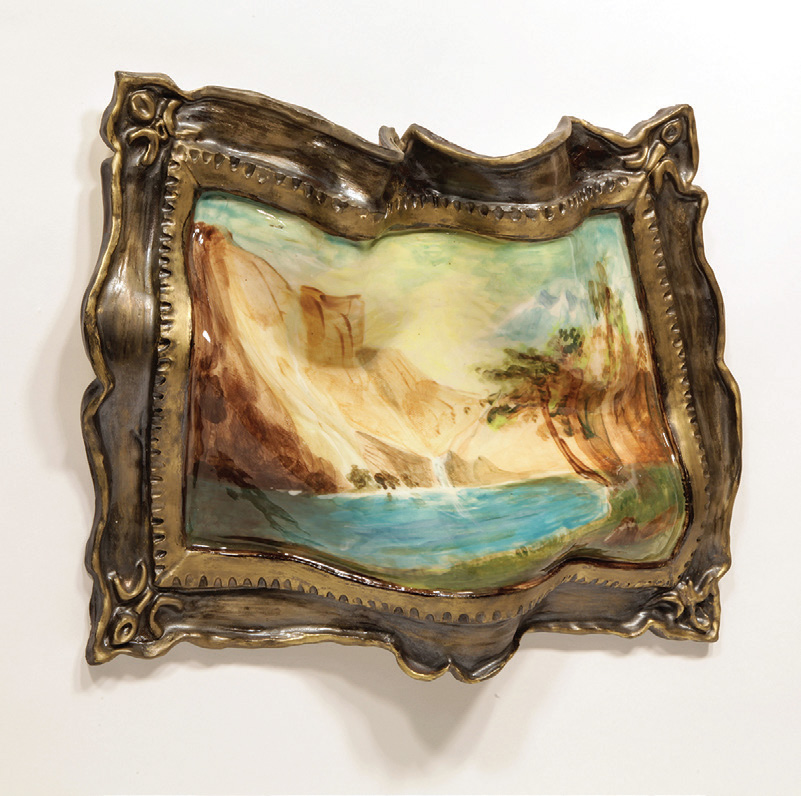
Hegarty’s piece is a bit like a hidden explosive in regard to seeing the land and the legacy of seeing. The material itself, ceramic, has a very complex history within the categories of fine art. In some cultures, ceramics are highly valued, but in Western art they have generally been deemed decorative, thus not really art. That Hegarty works in this material has a decidedly gendered and racial context: The very bodies and materials left out of some dialogues about land and visualization will be edged back in, even by her choice of the material to use.
She is also confronting one of the most famous and collected of American landscape artists, whose works have come to define a particular aesthetic of the American West. Bierstadt, an artist originally from Germany, produced images of the western territories after the Civil War and visually redirected a conversation from the trials of war and race to what he depicted as an open and opportunity-filled frontier. This land, as Hegarty notes, was already occupied by Indigenous peoples; indeed, when Bierstadt was painting his majestic views of a naturally optimistic and open land, the U.S. federal government was warring with numerous tribes, forcing them to relocate, and negating or simply ignoring treaties. In short, this was a period of slaughter and sorrow across much of the West, but that’s not what Bierstadt and other white landscape artists of the time depicted. Their imagery was about victory, conquest, and the rich, ever-expansive lands that awaited white settlers and tourists.
Hegarty literally curdles this visual dialogue, twisting Bierstadt’s image so that it is still recognizable but forever altered. She argues that before we can move forward, we must intervene in the past. We must disassemble what has been made of the land and its meanings and make it into something new. We’ve seen this kind of reclamation before; Mickalene Thomas, for example, is doing similar work with the legacy of black women’s bodies in visual culture. Both artists charge that it is not enough to simply pivot to “new” imagery. Nothing can be new without dismantling the visual past. Thus, as Thomas attempts to visually recreate a “who,” Hegarty pulls in the “when” of how we look now.
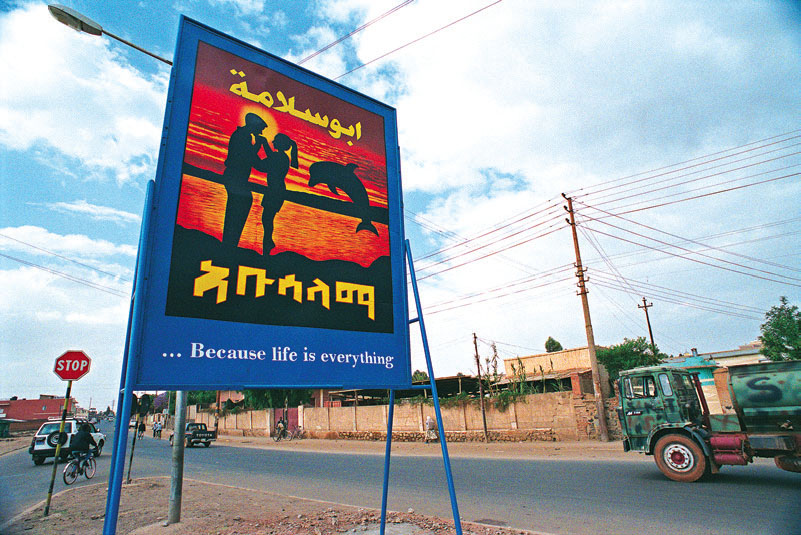
Photographer Scott Wallace’s “Eritrea” (2004) captures the ways in which we as viewers are asked to see our planet in strange and often complex ways. The poster in the image is part of a safe-sex campaign encouraging the use of condoms to confront the spread of AIDS. The message, written in three languages, is the only text on the poster. It is up to the viewer to make the necessary visual associations: a couple on a beach, a sunset, a dolphin jumping in the air.
In the photograph, the landscape of this poster, which was manipulated to speak to a very specific human concern, gets dropped into another landscape. Wallace neatly captures the dissonance of the image and its display in a busy intersection. It is such a unique advertising poster, but of course how many people (save Wallace) actually really look at it in this moment, in this place? Or was that the point all along, to make an image of love, sex, death, oceans, and dolphins that is viewed but maybe not deeply considered? The advertisement then just seeps into the unconscious, bumping into all our other images of love, sex, death, oceans, and dolphins. Wallace pulls it back, highlighting how we see the land, the earth, animals, nature, in a myriad of competing ways all the time. What sticks? When will all this matter?
We need to know more about how our visual cultures are produced and really look at what we visually consume all day. We need to know what authorities and biases and histories are embedded in the images and things. We need to be able to accept some and reject others. We need to remember that Ghosh is not merely whispering in our ear; he is yelling and pleading and begging. We need to see the land. We need to see that when is right now.
Alexis L. Boylan is Director of Academic Affairs at the Humanities Institute of the University of Connecticut, where she is also Professor in the Art and Art History Department and Africana Studies Institute. She is the author of “Ashcan Art, Whiteness, and the Unspectacular Man” and “Visual Culture,” from which this article is adapted.
